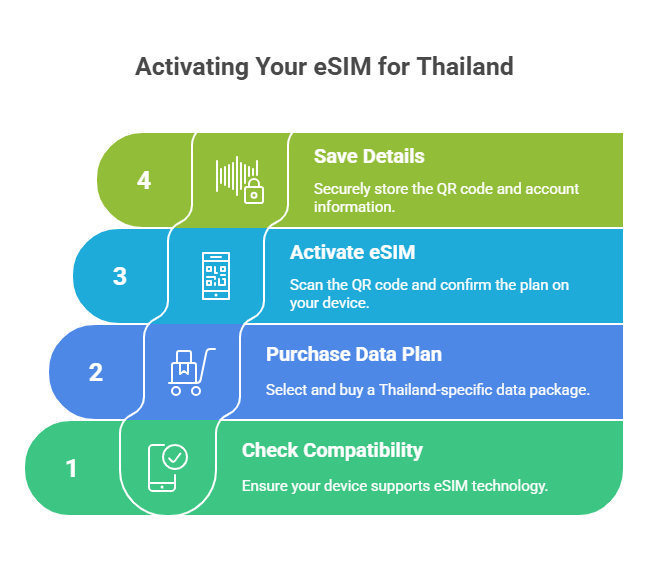eSIMs offer a convenient, hassle-free way to enjoy data coverage across Thailand, letting you focus on what matters—exploring the Land of Smiles. Below, we’ve detailed everything you need to know about eSIM options for your trip to Thailand, including how to set one up, pricing insights, practical use cases, and frequently asked questions.
What Is an eSIM and Why Choose It for Thailand?
An eSIM—or embedded SIM—is a digital SIM card embedded directly into your smartphone, tablet, or even smartwatches. Unlike traditional SIM cards, an eSIM eliminates the need for physical swapping or handling. You can activate an eSIM remotely through an activation code or QR scan, making it an attractive option for travelers.
Benefits of Using an eSIM in Thailand
1. Seamless Connectivity
With an eSIM, you can land in Thailand and immediately connect to a local data network without visiting a telecom store or hunting for Wi-Fi.
2. Wide Coverage and Data Reliability
Thailand offers extensive eSIM coverage through networks like AIS, TrueMove H, and DTAC. These networks are known for their reliable speeds and broad geographical coverage, so you won’t lose connection whether you’re lounging in Bangkok or trekking in Chiang Mai.
3. Digital Nomad Friendly
Need consistent data for remote work? eSIM plans in Thailand offer generous data packages tailored for digital nomads and business travelers.
4. Eco-Friendly
Forget disposable plastic SIM cards. By using an embedded SIM, you contribute to reducing plastic waste.

How Much Does an eSIM Cost in Thailand?
Pricing for eSIM plans in Thailand varies depending on the total data allowance and usage duration. Here’s a general breakdown:
- Short-Term Visitors
A 3 GB to 5 GB plan for 7–15 days typically costs $8–$15 USD, perfect for casual travelers.
- Long-Term Travelers or Nomads
If you plan to stay 30 days or longer, data packages between 10 GB and unlimited plans range from $20–$40 USD. Some providers even offer flexible top-up options suitable for extended travel.
- Top Providers
Terminal eSIM partners with premium providers that give transparent pricing and ensure no hidden fees. Check out the best eSIM plans for Thailand at Terminal eSIM.
Hidden Costs to Watch For
- Roaming Fees for International eSIMs
Some international eSIM providers impose roaming fees in Thailand. Always opt for plans explicitly optimized for Thailand to avoid surprise costs.
- Add-On Services
Certain local plans add taxes or activation fees—pay attention to the fine print when comparing prices.
Setting Up Your eSIM Before You Arrive
One of the great advantages of eSIM is that setup is quick and straightforward—no technical expertise required. Here’s how you can get started before boarding your flight to Thailand:
Step 1: Check Device Compatibility
Make sure your smartphone is eSIM-compatible. Most modern devices, including iPhone XS or later, Samsung Galaxy S20 and newer, and Google Pixel 3 or newer, support eSIMs.
Select a Thailand-specific data package from a trusted source like Terminal eSIM, where plans are tailored for affordability and coverage. Upon purchase, you’ll receive a QR code.
Step 3: Activate Your eSIM
- Open your device settings and head to the cellular or connections menu.
- Select “Add Cellular Plan” and scan the QR code provided by the eSIM provider.
- Confirm your new plan, and you’re all set!
Pro Tip
Save the QR code and any account details in a secure location in case you need to re-activate the plan during your trip.

Why Use an eSIM in Thailand? (Important Use Cases)
For Casual Travelers
Whether you’re exploring the vibrant nightlife of Bangkok or the pristine beaches of Krabi, an eSIM ensures uninterrupted access to maps, travel apps, and online booking platforms.
For Digital Nomads
Thailand is a hotspot for remote work, boasting coworking spaces and creative hubs. With an eSIM providing unlimited online access, you can Zoom with clients from a riverside café in Chiang Mai or upload content from a jungle retreat in Koh Samui.
For Business Travelers
Need to stay in touch with colleagues or access company servers? Upgrade to an eSIM plan with high-speed, priority connections for worry-free video conferencing and file sharing.
Frequently Asked Questions About eSIMs in Thailand
Is an eSIM Better Than a Physical SIM in Thailand?
Yes, because it eliminates the need for physical cards, is easier to set up, and offers flexible switching between carriers.
Can I Use My Home eSIM Provider in Thailand?
While some international eSIM providers offer global plans, they may charge premium roaming fees. Opt for a Thailand-specific eSIM to save costs.
What Happens If I Run Out of Data?
Most eSIM plans offer easy top-up options. You can seamlessly add more data from your provider’s app or website.
Can an eSIM Work for Voice Calls?
Yes, though many eSIM plans focus on data. Alternatively, use apps like WhatsApp or Skype for VoIP calls.
Is eSIM Coverage Available in Rural Areas?
Yes, major Thai carriers provide strong coverage across most rural and urban areas. However, speeds might vary in remote regions.
How Do I Cancel My eSIM After the Trip?
Simply remove the eSIM profile from your device settings. This doesn’t impact any other subscriptions or active connections.



